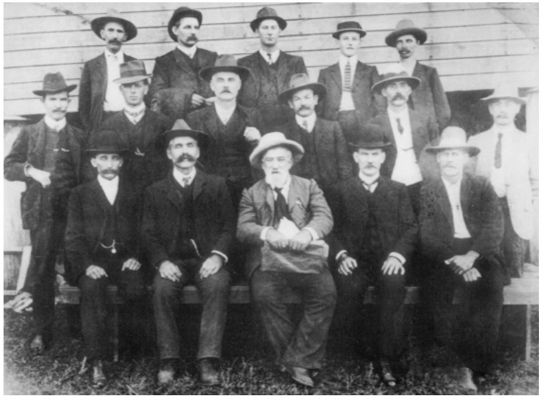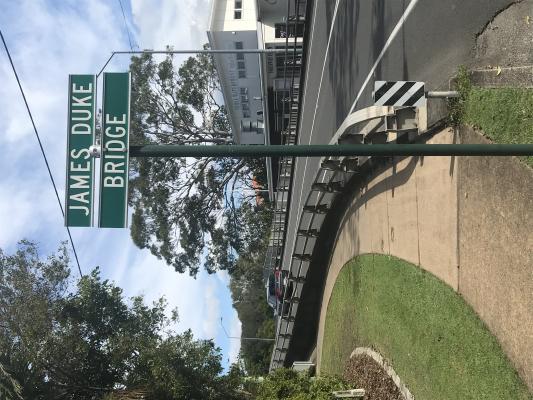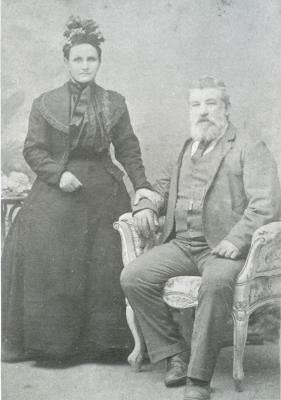James Duke Bridge, Noosaville and Duke Road, Doonan
James Duke gets a bridge and a dress circle hinterland road named after him largely owing to the fact that he became the first chairman of the newly-created Noosa Shire in 1910.
Born in Liverpool, England, in 1841, Duke had worked his passage to Australia in 1863 as an able seaman on the Everton, but the ship was caught in a gale and wrecked on Moreton Island. Nothing about Duke’s subsequent life in what was to become Noosa Shire ever quite matched the excitement of his arrival, but he rose to the position of general manager at timber giant Dath Henderson and Co, owned the first building in Cooroy, raised a family in Tewantin and developed considerable landholdings in what is now known as Doonan.
When elected chairman he was 69 years old (add 20 to that in today’s life spans), and he was seen as a caretaker with a safe pair of hands for the short time it would take to get the council on track.
Noosa had been part of Gympie-based Widgee Shire since 1879 when the colonial Queensland government created 10 local government divisions, but by the new century talk of separating from Widgee was a constant around the gentlemen’s lounges of Tewantin, particularly at Dan Martin’s Tewantin Hotel, and within days of hosting Walter Hay’s wake in 1907, Martin, the Noosa representative on the Widgee board since 1895, found himself voted off, presumably in an attempt to quieten the separatists. It didn’t work. In November 1909 the Home Secretary’s Office served notice on the Widgee Shire Council that it intended to form the Shire of Noosa. The proclamation set forth “that the election shall be held at the Federal Hall, Cooran, on the 31st March, 1910”.
There were 15 nominations for the nine councillors required, and with fewer than 700 ratepayers eligible to vote, the results were fast and decisive. At the first meeting of the Noosa Shire Council on May 11, 1910 (also held at the tiny Federal Hall, Cooran, to comply with the proclamation) the councillors elected James Duke as their founding chairman.
The first major business of the new council was to divide the shire into divisions, and it was decided to create three divisions, with the roads leading into Cooroy, Pomona and Cooran forming the boundaries, with each division having three representatives. But if creating the divisions had seemed relatively simple and pain-free, choosing the site for the council chambers was to be anything but.
Cooran’s term as the seat of the shire was always meant to be temporary, but at the first council meeting its residents made sure it was one of four centres that vied for the permanent honour. Cooran, Tewantin, Cooroy and Pomona all nominated and Cooroy won the final vote and started hiring contractors and buying timber from the Cootharaba mill to build the shire chambers.
But within a few months the decision had caused uproar throughout Noosa, with representatives of the other divisions presenting a petition to the Home Secretary demanding that Pomona be selected because it was more central. In a referendum on March 11, 1911, Pomona pipped Cooroy by just 11 votes. As builders were sacked and timber sent back to the mills, Noosa Shire moved onto the more pressing but less entertaining business of the day. The Shire was broke.
Discussing the issue of a new bridge for Cooran, shire clerk Edgar Edwards did not hold back: “The Financial aspect of this matter is enough to turn all the Councillors grey. The Council have nothing, absolutely nothing, if I want a piece of India rubber in the Office I have to go out and buy it, there is not a pick or a shovel belonging to them, there is all the initial expense of getting things, there is the problem of more miles of bad roads or worse than bad roads, no roads, to face, than I care to think of.”
This was enough poppycock for old Jim Duke, who handed the robes to Frank Conroy, a sawyer who lived in a humpy near Cooran with neither power nor running water, and saw out his term on the back bench as a councillor. He died at Tewantin in 1921.
READER REQUESTS
This column makes no guarantees, but readers are welcome to enquire about the origins of their street names. We’ll do our best.
Wantima Street, Noosa Heads
Grant Linkhorn asked what we knew about Wantima. An easy one to start, thanks Grant. Wantima is the Kabi Kabi word given to the Noosa headland, meaning “rising up”, as it does, particularly when viewed from the campsites in the scrub along what is now Hastings Street, an area known to the Kabi as Gnuthera, meaning “shadow” or “shade of a tree”. The name Noosa is believed to be a corruption of Gnuthera.








